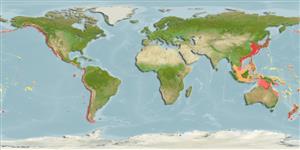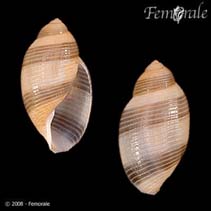Rictaxis punctocaelatus (Carpenter, 1864)
Spotted rictaxis| Native range | All suitable habitat | Point map | Year 2050 |

|
| This map was computer-generated and has not yet been reviewed. |
| Rictaxis punctocaelatus AquaMaps Data sources: GBIF OBIS |
Classification / Names Common names | Synonyms | CoL | ITIS | WoRMS
Gastropoda | Not assigned | Acteonidae
Environment: milieu / climate zone / depth range / distribution range Ecology
Benthic; depth range 0 - 252 m (Ref. 101078). Subtropical
Distribution Countries | FAO areas | Ecosystems | Occurrences | Introductions
Eastern Pacific: Alaska and Mexico. Tropical to temperate.
Length at first maturity / Size / Weight / Age
Maturity: Lm ? range ? - ? cm Max length : 2.0 cm TL male/unsexed; (Ref. 822)
Assumed maximum length from Ref. 822. Common on shallow waters. Found gliding just under the surface of the sediment (Ref. 822).
Life cycle and mating behavior Maturity | Reproduction | Spawning | Eggs | Fecundity | Larvae
Members of the order Heterostropha are mostly simultaneous hermaphrodites.
Main reference
References | Coordinator | Collaborators
Behrens, D.W. and A. Hermosillo. 2005. (Ref. 822)
IUCN Red List Status (Ref. 130435)
CITES status (Ref. 108899)
Not Evaluated
CMS (Ref. 116361)
Not Evaluated
Threat to humans
Human uses
| FishSource |
Tools
More information
Age/Size
Growth
Length-weight
Length-length
Morphology
Larvae
Abundance
Growth
Length-weight
Length-length
Morphology
Larvae
Abundance
Internet sources
BHL | BOLD Systems | CISTI | DiscoverLife | FAO(Publication : search) | Fishipedia | GenBank (genome, nucleotide) | GloBI | Gomexsi | Google Books | Google Scholar | Google | PubMed | Tree of Life | Wikipedia (Go, Search) | Zoological Record
Estimates based on models
Preferred temperature
(Ref. 115969): 7.7 - 23.6, mean 14.5 (based on 508 cells).
Price category
(Ref. 80766):
Unknown.



